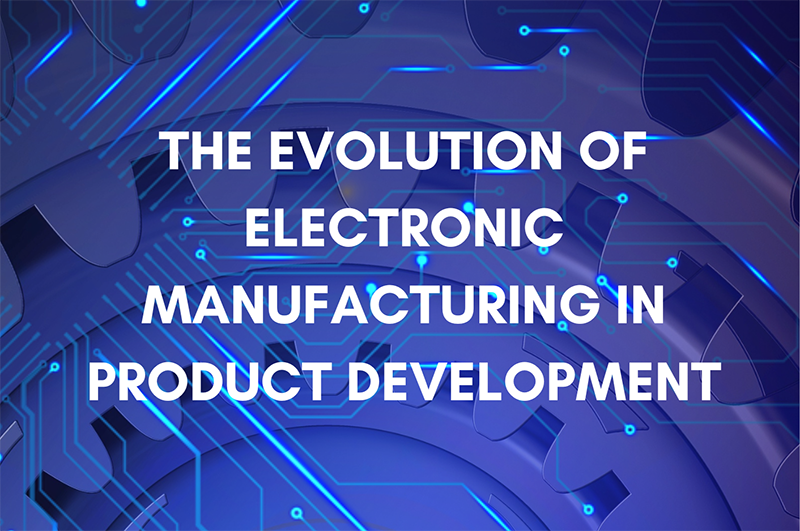The Evolution of Electronic Manufacturing in Product Development

Embracing Tomorrow: The Evolution of Electronic Manufacturing in Product Development
Innovation in electronic manufacturing has been a driving force behind the technological leaps that define our era. From the dawn of the integrated circuit to the era of smart devices and the Internet of Things (IoT), electronic devices have become an indispensable part of our lives. Driving this ever-evolving ecosystem is the intricate machinery of electronic manufacturing, a sector poised for a transformative leap into the future.
Industry 4.0: The Symphony of Automation
Imagine a factory floor humming with the synchronised ballet of robots, their precise movements guided by artificial intelligence (AI). Data flows seamlessly through interconnected systems, optimising production in real-time. This is the essence of Industry 4.0, the fourth industrial revolution, and it’s poised to revolutionise electronic manufacturing.
- Robots as Colleagues, Not Replacements: While fears of automation replacing human workers may linger, the reality is more nuanced. Robots will excel at repetitive, high-precision tasks, freeing up human talent for strategic oversight, creative problem-solving, and innovation that remain uniquely human strengths. The collaborative robot, or “cobot,” will become a familiar sight, working alongside humans in a symbiotic relationship that boosts efficiency and safety.
- AI, the Orchestrator of Efficiency: AI will be the invisible conductor, orchestrating the symphony of interconnected machines. Predictive maintenance algorithms will anticipate equipment failures before they happen, minimising downtime and ensuring smooth production flow. AI-powered quality control systems will scan for microscopic defects with unerring accuracy, safeguarding product quality.
Miniaturisation and Increased Efficiency
The relentless pursuit of miniaturisation is an ongoing trend in electronic manufacturing. Components are getting smaller while becoming more powerful, paving the way for ultra-compact devices with enhanced functionalities. This shift toward miniaturisation isn’t just about size; it also emphasises energy efficiency, enabling devices to operate longer on smaller power sources.
Advancements in nanotechnology and materials science are driving the development of smaller, more efficient components. Nanomaterials are being explored for their unique properties, allowing manufacturers to create electronics that are not only smaller but also more durable and energy-efficient.
Customisation and Personalisation
The future of electronic manufacturing isn’t just about mass production; it’s about customisation and personalisation. Technologies like flexible electronics and modular designs enable the creation of tailored solutions for diverse consumer needs. Customisable devices allow users to personalise their gadgets, choosing features and functionalities that align with their preferences.
The future of electronic manufacturing in product development is an amalgamation of miniaturisation, agility, sustainability, AI integration, IoT connectivity, and customisation. As technology evolves, so will the possibilities for innovation in electronic products. Embracing these trends will redefine how we perceive electronic devices and revolutionise industries and daily life in ways we have yet to fully comprehend.
The Internet of Things (IoT): A Web of Intelligence
Imagine every component, every machine, every piece of the manufacturing process talking to each other, sharing data in real-time. This is the promise of the IoT, where sensors embedded in everything from circuit boards to forklifts communicate vital information. This constant data stream will fuel AI algorithms, providing deeper insights into the production process and enabling dynamic adjustments for optimal performance.
Sustainability: Weaving Green Threads into the Fabric of Production
The future of electronic manufacturing is not just about efficiency and innovation; it’s about building a sustainable future. Environmental concerns are at the forefront, driving the adoption of cleaner production processes, renewable energy sources, and responsible material sourcing.
Circular Economy: Giving Electronics a Second Life
The concept of a circular economy, where resources are kept in use for as long as possible and waste is minimised, is gaining traction. Manufacturers are exploring ways to design electronics for easy disassembly and recycling, giving materials a second life and reducing reliance on virgin resources.
Green Powering the Production Line: Renewable energy sources, like solar and wind power, are increasingly powering factories, reducing carbon footprints and reliance on fossil fuels. Additionally, energy-efficient equipment and optimised production processes are further minimising the environmental impact of electronics manufacturing.
The Human Touch: Building a Workforce for the Future
As the industry evolves, so too must the workforce. The future of electronic manufacturing demands a skilled and adaptable workforce equipped with the knowledge and expertise to navigate the complexities of Industry 4.0. Continuous education and training programmes will be crucial to bridge the skills gap and ensure a future-proof workforce.
Reskilling and Upskilling: Existing workers will need to upskill and reskill to adapt to the changing landscape. Training in robotics, AI, data analysis, and cybersecurity will be vital for success in the future factory.
Fostering a Culture of Innovation: Encouraging a culture of innovation and collaboration will be key to unlocking the full potential of the future workforce. Open communication, knowledge sharing, and a focus on continuous improvement will be essential for driving progress and staying ahead of the curve.
The Road Ahead: Navigating the Evolving Landscape
The future of electronic manufacturing is paved with both promise and challenges. Embracing technological advancements like Industry 4.0 and AI, prioritising sustainability, and investing in a skilled workforce are not just options; they are necessities for long-term success. By navigating the evolving landscape with a spirit of innovation and collaboration, the future of electronic manufacturing can be one of progress, sustainability, and shared prosperity.
The Human-Machine Connection
As we enter this new era of electronic manufacturing, it’s important to remember that the human element remains central. The machines may be intelligent, the processes automated, but it is the ingenuity, creativity, and dedication of human minds that will guide the future of this industry. The future is not about machines replacing humans, but about humans and machines working together in harmony, weaving a new chapter in the remarkable story of electronic innovation.
Pivot International has over 50 years of experience in electronic manufacturing. With 14 locations globally, we offer our customers scalable manufacturing with competitive pricing. Our teams of engineers can help design your product from an idea or help re-engineer your fully developed product to make it more efficient. Contact us today to learn more.

